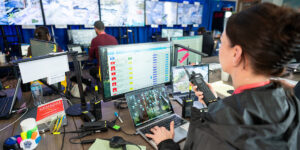
Fortress at Risk: Critical Infrastructure and Violent Extremism
Thomas Brzozowski
August 27, 2025
Extremism gives rise to individuals, groups, and networks who see critical infrastructure as a prime target for violence. In reality, the concept of a shared-responsibility model can falter under the strain of a cascading failure. Preparation depends less on policy and more on practiced coordination before an incident occurs.

A Sixth Framework? Civil Defense and the Future of Emergency Management
George M. Schwartz
August 27, 2025
Comprehensive emergency management in the U.S. evolved from World War II and Cold War-era civil defense, but today, civil defense plays little to no role in emergency management policy. With most Americans expecting a major conflict within the next decade, it is time for a sixth framework.

Editor’s Note: Terrorism Preparedness—A Role for Everyone
Catherine L. Feinman
August 27, 2025
In any emergency preparedness role, terrorism and violent extremism can no longer be considered someone else’s problem. Countering terrorist and extremist threats requires comprehensive preparedness strategies, effective intelligence sharing, and strong partnerships.

The Evolving Landscape of Domestic Extremism
Richard Schoeberl
August 20, 2025
Extremism in its many forms remains a growing threat in the U.S. There is heightened concern about ongoing violent extremist reactions to both domestic sociopolitical developments and international events that may be used to justify attacks. Countering this threat requires a comprehensive strategy, including improved intelligence efforts, stronger partnerships, and expanded investigations and prosecutions.

Podcast – How 5G Technology Propels Emergency Response
David Brossette and Robert Edwards
August 20, 2025
In this podcast episode of Domestic Preparedness: The Podcast, host Nicolette Casey Phillips speaks with David Brossett and Robert Edwards from Ericsson. They discuss how 5G technology is powering connected first responder vehicles and mobile command centers and transforming real-time situational awareness for first responders. This conversation was recorded on May 28, 2025, during the Texas Emergency Management Conference in Fort Worth, Texas.

FIFA, Terrorism, and Preparedness for the 2026 World Cup in the U.S.
Adam Johnson
August 20, 2025
The quadrennial championship of the most popular game in the world—soccer—is coming to the United States in 2026, and fans from around the world will be in attendance. With the world watching the events, terrorists may try to capitalize on the World Cup’s notoriety. Local governments and community members need to prepare.

Threat Detection at Events: A Collaborative, Layered Approach
Tami Richter
August 13, 2025
Large-scale events are high-visibility targets for threats and terrorism, and disruptions can range from minor to catastrophic. Preventing such incidents requires a multilayered approach across all event phases. While large events draw the most attention, smaller gatherings can be just as vulnerable and should not be overlooked.

Preparing Small Communities for Terrorist Attacks
Rodney Andreasen
August 13, 2025
Terrorist attacks have broad psychological, social, and economic impacts that often extend beyond the initial target. While large cities are typical targets due to their prominence, smaller communities are not immune, and an attack could overwhelm limited resources and devastate a community.

John Wilson on Knowing What to Do When Stuff Hits the Ground
Domestic Preparedness
August 13, 2025
John Wilson is well-versed in emergency management and hurricane preparedness. In this discussion with Domestic Preparedness, he shares his lessons learned about the evolution of emergency management and the evolving challenges that preparedness professionals face today.

Reimagining Readiness: The Future of Emergency Management in Homeland Defense
Cody Santiago
August 6, 2025
Underdeveloped civilian emergency management integration with Department of Defense resources results in gaps in preparedness, intelligence-sharing, and response coordination. A more integrated framework can incorporate emergency management as a core pillar of homeland defense, improve intelligence-sharing, and strengthen resilience.

